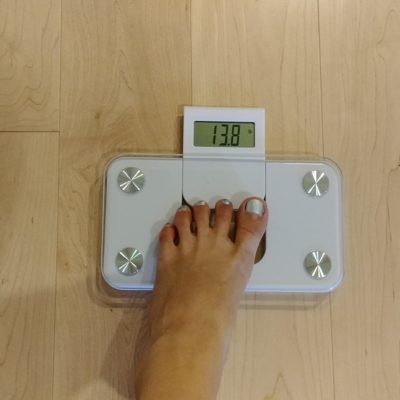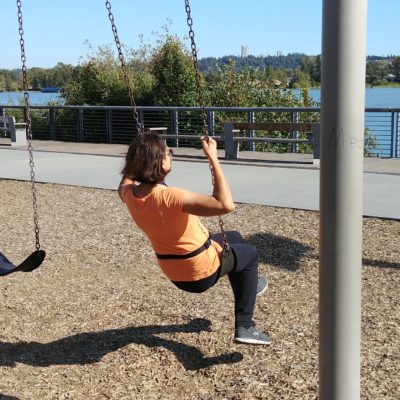When you become my client, this is one of the first questions I will ask you:
What does fitness look like to you?
Emphasis on the “to you” part. Asking this question challenges us to look at fitness from an individualized perspective. To recognize that one person’s ideal of fitness can be completely different from the next person’s idea of fitness.
Over the years, I’ve heard answers ranging from wanting to be able to do a pull-up, to walking up the stairs without getting winded.
No two answers are ever the same, and what’s brilliant is each answer is unique to that individual.
So how do you answer that question? First, we need to look at how not to answer it.
How we usually define “fitness”
We often create our definition of fitness based on what we think we should be doing.
“I should be able to get up at 6am and attend bootcamp 3 times per week.”
Or we pick some unrealistic standard we see on social media:
“Wow, look at those defined muscles! Mine need to be like that too – that’s when I’ll be fit”
Finally, and most damaging to our own confidence and self esteem, we take someone else’s standard of fitness and make it our own:
“That person is able to do XYZ (push-ups, pull-ups, burpees, etc). I need to be able to do those things too”
Then, since we clearly cannot do XYZ, we conclude that we suck.
A traditional definition of “fitness” can do a lot of damage…
When I became a personal trainer, I was super excited about my new role. I started being more public with what I was doing, sharing my story and my love for fitness.
During that time, my definition of a “personal trainer” was pretty much your standard one: someone who was able to maintain a stellar daily fitness routine; who loved the gym and working out; and who was extremely fit.
So I worked really hard to uphold that standard, because now I felt like my audience was watching. I started in fitness by doing P90X and I continued doing extreme workouts in the name of feeling like I was meeting the definition of being a “fit personal trainer”
After a while however, a few things happened:
It felt like what I was doing was unsustainable. It was hard to keep up and I was sore ALL THE TIME! Which can be fun at the start (yay, changes!) but after a while it really starts to bother you being in pain all the time.
I also started questioning whether the standard I was trying to uphold made sense. So…if I went to the swimming pool, or went for a long walk….that didn’t count as exercise!? According to my definition – no, it didn’t.
And that started to feel kind of ridiculous.
By taking a standard definition of fitness and embracing it the way I did, I had essentially created a prison for myself.
What life things do you want to be doing?
Instead of blindly jumping in an exercise regime, take some time and determine what matters to you.
What life things do you want to be doing?
How do you want to move your body? With what purpose?
I love going for walks; a day hike; rollerblading; a bike ride with my kid; splashing around at the swimming pool for a couple of hours; skating.
I enjoy these things because I get to spend time with the people I love, and I build memories in the process.
These things don’t fit the category of conventional “workouts” but am I moving my body? You betcha!
Letting go of your own conventional definition of fitness is not an easy task – but feeling crappy that you’re not meeting some arbitrary fitness standard sucks too.
So I took a leap of faith and decided to change things up. I started doing spin and yoga, and embraced a much more varied routine. which involves a combination of formal routines but also other fun activities (one week I tried belly dancing!). In the process, I re-discovered joy in my fitness and I’m no longer sore all the time.
I switched my mindset from formal intense workouts to the idea of daily movement, and I’m sure my joints will thank me for that in the future.
Create sustainable goals
Should you work out every day? Does every workout need to be one hour?
I don’t think so. These are completely arbitrary standards – if they make you anxious, or if you’re struggling to keep up – to hell with them!
If you don’t enjoy what you’re doing, it will turn into a chore. And no one likes chores.
I am a big fan of a concept called The Health Zone – the idea that your fitness levels and activities vary depending on what life throws at you.
It makes so much sense – our lives change all the time. Why should our fitness regime stay the same?
(It’s such an important topic that it deserved its own article, so I wrote one. Check it out: Meet your new best friend: Your Health Zone)
Instead of creating fixed goals that never change (and then feeling crappy when you don’t meet them), create a range:
What is the minimum that you can commit to regarding your health and wellness? (ex: “I will walk to the skytrain every day instead of taking the bus”)
What is your maximum that you can commit to? (ex: “The walks above, plus 2 workouts with my trainer, and one hike”)
As long as you’re between your lower and upper range, you’re doing good 🙂
Keep a trial and error mindset
Your first pass at creating a fitness regime may or may not give you optimal results. That’s completely normal.
If you try something and it doesn’t work – ask why that was! Perhaps it wasn’t realistic, or didn’t take into account certain aspects of your life. That’s a great lesson to learn – now you know, and you can apply your finding to the next iteration.
Don’t get frustrated or expect instant results – be prepared to tinker with, and change things up.
People who successfully create an exercise regime recognize that not everything will work out, and that’s ok – when that happens, you simply learn the lesson and move on to the next thing.
Related: The 7 secrets of highly successful exercise people
In conclusion…
Don’t adopt someone else’s definition of fitness. Instead, create your own, remembering there is no right or wrong.
Wanting to run a half marathon, or wanting to successfully walk around the block are both perfectly acceptable goals. Be realistic, and change things up when you need to! The most important thing is to make fitness work for you.
And then enjoy the journey it takes you on!
Let’s work together
I love working with people who are ready and committed to making long term changes in their lives.
My clients:
- Are curious about their body and want to learn its inner workings
- Are willing to commit the patience and time it will take to see long-lasting results
- Want to build strength and stamina so they can do whatever life things they want to be doing
Does that sound like you?





